Your child is ready to learn how to front float if he can hold his breath and put his whole face in the water for at least 10 seconds. If he’s not quite there yet, start with Help Your Child Learn to Put Their Face in the Water.
February 2019 update: I originally wrote this blog post in 2016, and while it still holds up for children 4-years-old+, I have since discovered another fantastic approach to teaching floating. And not only is this technique extremely effective for this age group, but it is also just as persuasive and motivational for the 2-year-old+ child. I included two videos to show you the process. Click here and here.
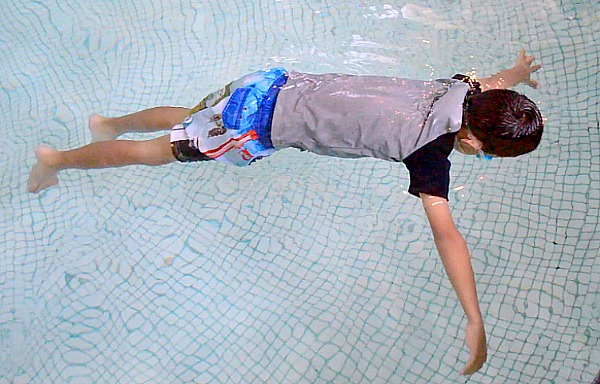
To teach your child to float, you’ll need access to a swimming pool with wide shallow steps. If that’s not an option, then a bathtub is a good starting point. (Never leave your child unattended in a bathtub) An ideal water temperature is ninety to ninety-five degrees Fahrenheit.
Goggles and a nose clip
Head position for a successful front float
Arms and legs should remain under the water
When first learning how to float, most children will arch their back, lifting their head and feet out of the water, resulting in their body dropping towards the bottom.
With more practice, they begin to relax and start to trust that the water will float them. The instinctive need to flail limbs becomes a thing of the past.
Let the feet be where they want to be
Many children will try to kick their feet up toward the surface, believing that a front float needs to be horizontal.
Everybody floats differently. It all depends on your body composition. Some bodies float with the feet on the bottom. Others float horizontally, and many bodies float somewhere in between. Each scenario is a perfectly good front float.
Encourage your child to do nothing with their feet. Let the feet be where they want to be. Easier said than done.
Is the water floating you?
If your child can hold himself up in a front float in the bathtub as described below and he can do this for at least ten seconds and is not trying to kick his feet up, it’s time to check in with him.
Ask him, “is your body floating?” “Is the water holding you up or are you holding yourself up?” Your child will probably say that the water is floating him. A step in the right direction.
Practice the front float in the bathtub
Have your child hold himself up in a push-up position with his arms supporting his weight. Now have him hold his breath, lower himself down and put his face in the water.
Encourage him to keep his face in the water to the count of ten (10 seconds). He may not want to do it for that long at first. Remember to practice patience and let him go at his own pace.
Practice this a few times during bath time or as many times as he wants. When he can do this for at least ten seconds consistently while his head is in a neutral position and he can let his feet be where they want to be, he can experiment with letting go.
Practice on the shallow steps of a swimming pool
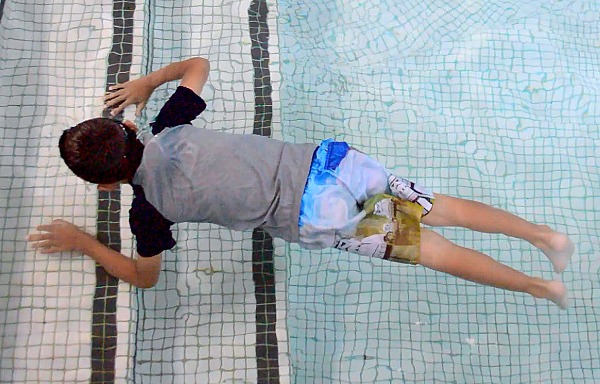
Demonstrate this first. Place your hands on a step, take a breath and lower yourself down into the water and stay there for at least a few seconds.
Now encourage your child to do the same. He may want to start by laying face down on the top step, which is probably not deep enough to float. That’s okay. Let him start there if he wants.
After a few attempts, encourage him to try one of the other steps but never force. He’s ready to experiment with letting go when he can hold himself up with his head in the water in a neutral position for at least ten seconds consistently, and he can let his feet be where they want to be.
Experiment with letting go while on the steps
When he’s comfortable with a supported front float, he’s ready to let go one hand at a time. Demonstrate this first.
Hold yourself up in a push-up position on one of the steps with your face in the water. Let go with one hand for a couple of seconds, then put it back down. Now it’s your child’s turn.
Support him at the hips and don’t let go. Promise him that you won’t let go and keep your promise. It’s important that you earn and maintain his trust. Assuming that went well, try it again and encourage him to let go with both hands.
Practice as many times as he wants. If it’s going well when he lets go with both hands, ask him if it’s okay if you let go of him now. If he says yes, then go for it. How long to let go will depend on your child. You can set goals to float longer with these games.
You can also help him float from your shoulders and from the wall. Once you’ve introduced him to all of the options, ask him how he would like to practice or suggest mixing it up.
Experiment with letting go of the shoulders
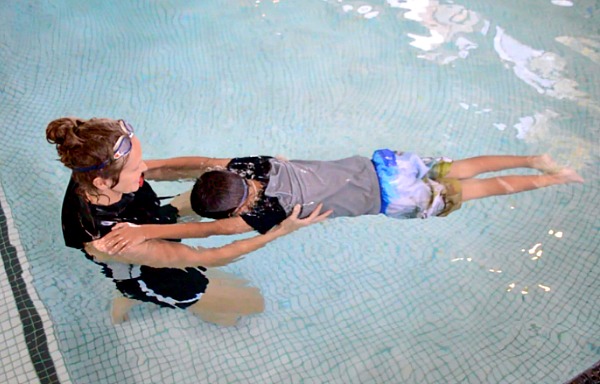
Position yourself with your back to the steps. Squat or sit down right in front of the steps or on a step and have your child place his hands on your shoulders while you support him at his hips or upper torso.
Have him take a breath, put his face in the water for ten seconds. As long as he has both hands on your shoulders, you can briefly let go of him.
Have him put his face in the water again and this time, encourage him to drop a hand from your shoulder and into the water. Make sure that he drops his hand rather than lifts it up and out of the water. The latter will cause him to sink a little. If all goes well, encourage him to drop both hands.
When he’s comfortable with this, ask him if it’s okay for you to let go of him now. If he agrees, let go after he drops his hands in the water, but keep your hands close just in case you need to catch him if he loses control.
Practice this as many times as he wants and set goals to float longer. If he needs motivation, try these games.
Experiment with letting go of the wall
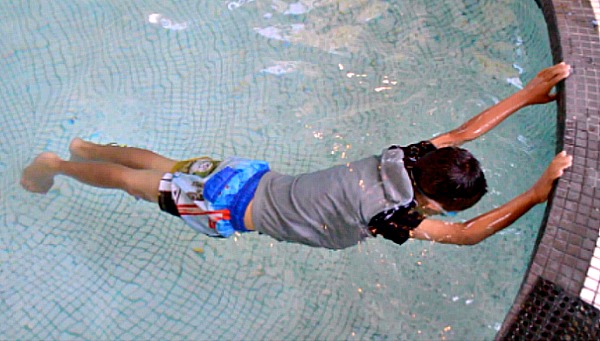
Have your child float while holding onto the wall or gutter. When he can do this for ten seconds, it’s time to let go one hand at a time. You may need to support him at his hips.
After he puts his face in the water, encourage him to let go with one hand. Make sure he drops his hand in the water, rather than lifting it up above the pool deck. Raising his hand will make his body drop.
Now it’s time to let go with both hands while supporting him. If all goes well, ask him if you can let go of him now. Remember to keep your hands close, just in case he panics.
To motivate him to float for long periods of time, try these games.
Learn to float while diving for rings
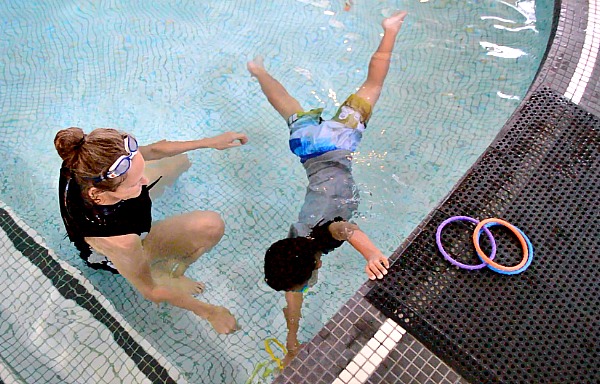
Some of my students have started to float when trying to dive for rings.
Drop the rings into the water beside the wall and next to the steps. Have your child hold onto the wall and squat down to pick up a ring. Encourage him to put his face in the water for each ring. He might need a little assistance to reach it since he probably won’t squat down far enough.
After about five to ten practice sessions, he’ll start to feel more confident and will be able to retrieve the rings independently and away from the wall.
Diving for rings in waist to chest-deep water is not only a fun challenge but also a great way to discover how to float.
Learn to sink, to learn to float
If your child still doesn’t trust that the water will float him, it’s time to teach him how to sink to learn how to float.
He’s ready to learn to sink if he can put his face in the water for at least ten seconds in a supported front float and he can let his feet be where they want to be.
Challenge him to try to sit down on the bottom. Demonstrate this if you need to. It’s not easy, but it’s fun to try.
Now it’s time to lay face down on the bottom. Demonstrate this first. If you accomplish this, your body will float back up to the surface. Instill in your child that it’s hard to sink because the water does such a good job of floating him.
Do it again and this time, have him push you down and sit on you if he wants to. It’s fun. My students love this game. Now challenge him to lay face down on the bottom. Before you know it, he’ll be floating.
How long will it take for my child to learn to float?
It all depends on your child and their level of fear. The more patient you are, the sooner your child will float. My most fearful students started floating independently after 9 or 10 thirty minute private lessons.
One day your child will just start floating, and it will be because you practiced patience, you let him go at his own pace, and you didn’t force him to do anything he didn’t want to do.
Now it’s time to Help Your Child Learn How to Back Float.

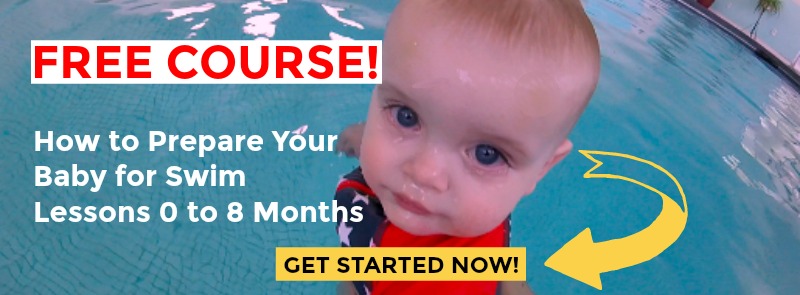

I have been struggling to get my legs to float whenever I tried to float. These tips have really helped me and now I am able to float on my belly without any difficulty. I too have a piece related to this topic @https://privateswimminglesson.sg/blog/10-tips-and-tricks-for-front-float. You can check it out in your free time.
Thanks for taking the time to comment. I’m glad you found the tips helpful. I enjoyed reading your blog post. Also, great tips!